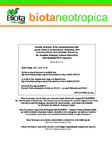Please use this identifier to cite or link to this item:
http://www.alice.cnptia.embrapa.br/alice/handle/doc/948641| Title: | Genetic structure of the ornamental tetra fish species Piabucus melanostomus Holmberg, 1891 (CHARACIDAE, IGUANODECTINAE) in the Brazilian Pantanal wetlands inferred by mitochondrial DNA sequences. |
| Authors: | BORBA, R. S. de  SILVA, E. L. da   PONZETTO, J. M.   POZZOBON, A. P. B.   CENTOFANTE, L.   ALVES, A. L.   PARISE-MALTEMPI, P. P.   |
| Affiliation: | RAFAEL SPLENDORE DE BORBA, UNESP, Rio Claro-SP; EDSON LOURENÇO DA SILVA, UNESP, Rio Claro-SP; JOSI MARGARETE PONZETTO, UNESP, Rio Claro-SP; ALLAN PIERRE BONETTI POZZOBON, UNESP, Rio Claro-SP; LIANO CENTOFANTE, UFMT; ANDERSON LUIS ALVES, CNPASA; PATRÍCIA PASQUALI PARISE-MALTEMPI, UNESP, Rio Claro-SP. |
| Date Issued: | 2013 |
| Citation: | Biota Neotropica, São Paulo, v. 13, n. 1, p. 42-46, 2013. |
| Description: | The subfamily Iguanodectinae comprises a group of small Neotropical fishes composed by two genera and 11 nominal species widely distributed in the Atlantic drainages of South America. Piabucus is the only genus of Iguanodectinae found in the Paraguay River basin, especially in the Pantanal of Mato Grosso State, where it is represented by Piabucus melanostomus. Given the wide distribution and the low dispersion capacity of this species, due the ecological constraints, it is possible that many interesting genetic features could be found in different populations. In this way, the aim of his work was to perform the phylogeographic pattern of P. melanostomus populations using mitochondrial DNA sequences. A total of 13 individuals from three rivers belonging the Mato Grosso wetland were sampled. The ATP sintetase (subunits 6 and 8) gene was completely sequenced, the mean of nucleotide base composition in the sequences was 31.2% (T), 30.2% (C), 26.9% (A) and 11.9% (G), with no gene saturation. The population analysis in the TCS program generated a network with six haplotypes (A to F), where the ancestral haplotype (A) has a frequency of 25% and is composed by individuals from Cuiabá and Paraguay Rivers. The phylogenetic analysis showed the occurrence of two mtDNA lineages (1 and 2), the distance observed between the two lineages was 0.6%. The phylogenetic and phylogeographic results as well as the negative values of Fst for some populations, indicate a possible occurrence of gene flow among the analyzed populations. These results highlights the importance of flood pulse existent on wetland as a vehicle that permits a temporary connection among isolated population maintaining the species genetic variability. |
| Thesagro: | Peixe ornamental Genética Mitocondria |
| NAL Thesaurus: | Ornamental fish Genetics Mitochondrial DNA Pantanal |
| ISSN: | 1676-0603 |
| Type of Material: | Artigo de periódico |
| Access: | openAccess |
| Appears in Collections: | Artigo em periódico indexado (CNPASA)  |
Files in This Item:
| File | Description | Size | Format | |
|---|---|---|---|---|
| Piabucus.pdf | 2.4 MB | Adobe PDF |  View/Open |









